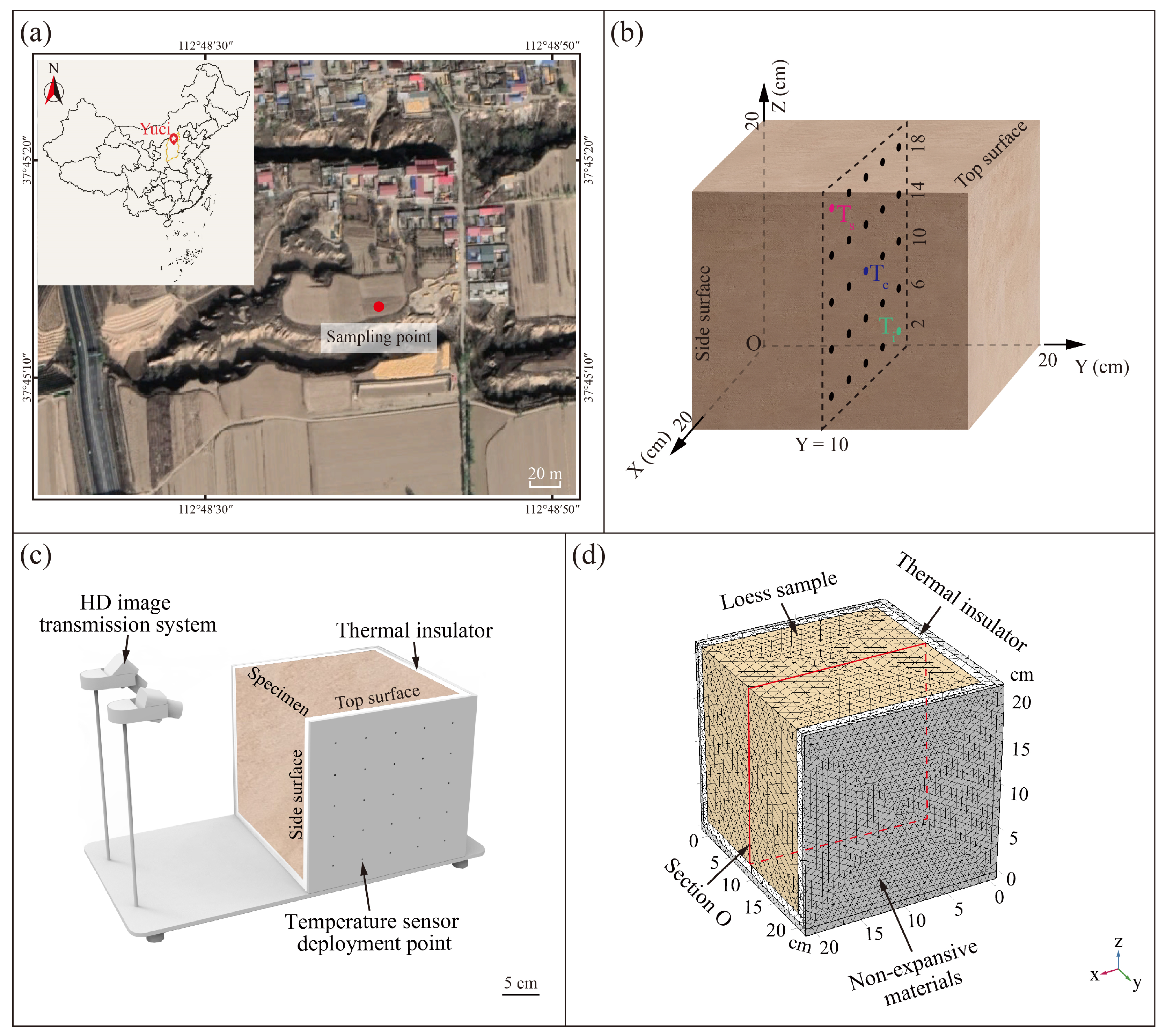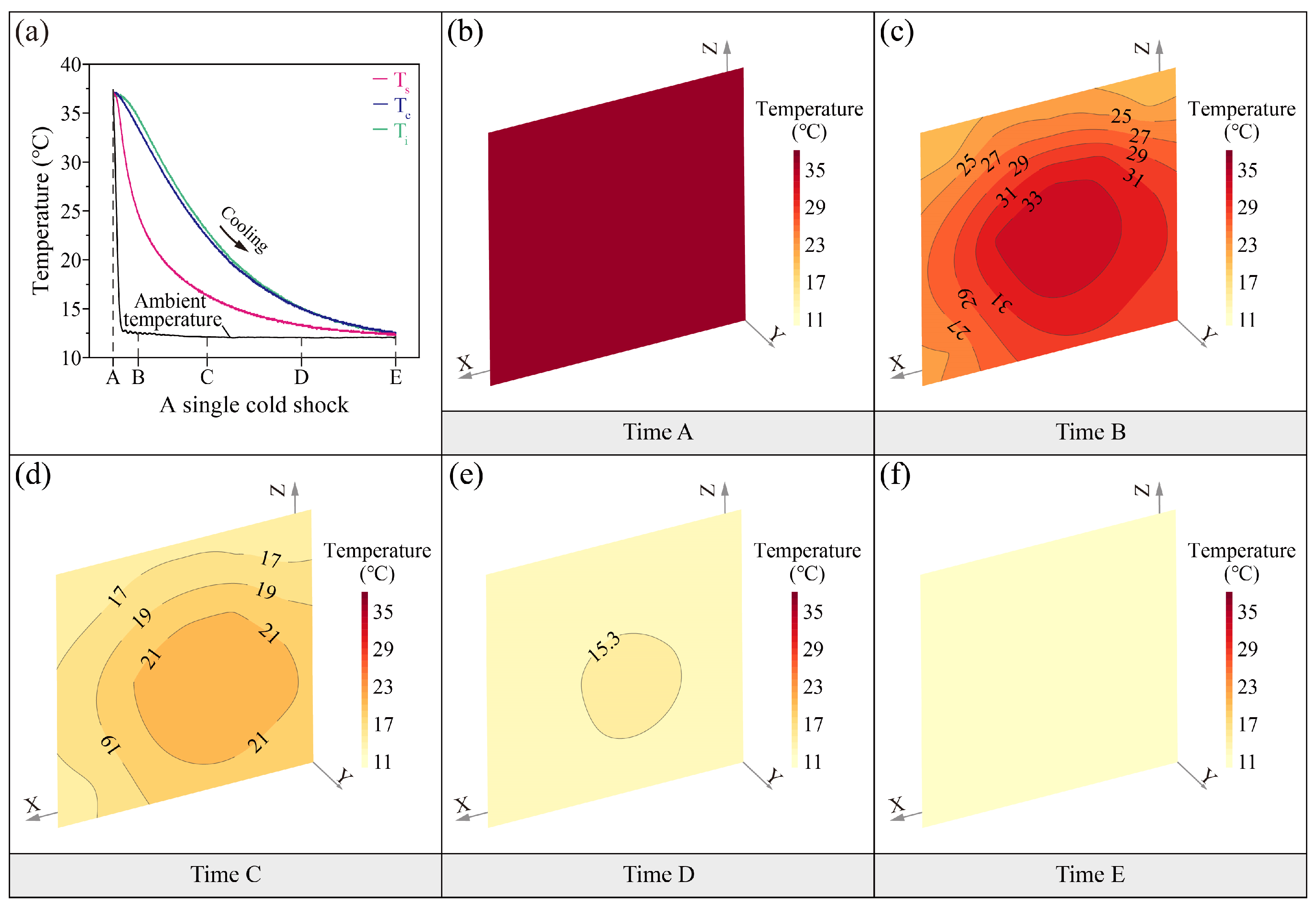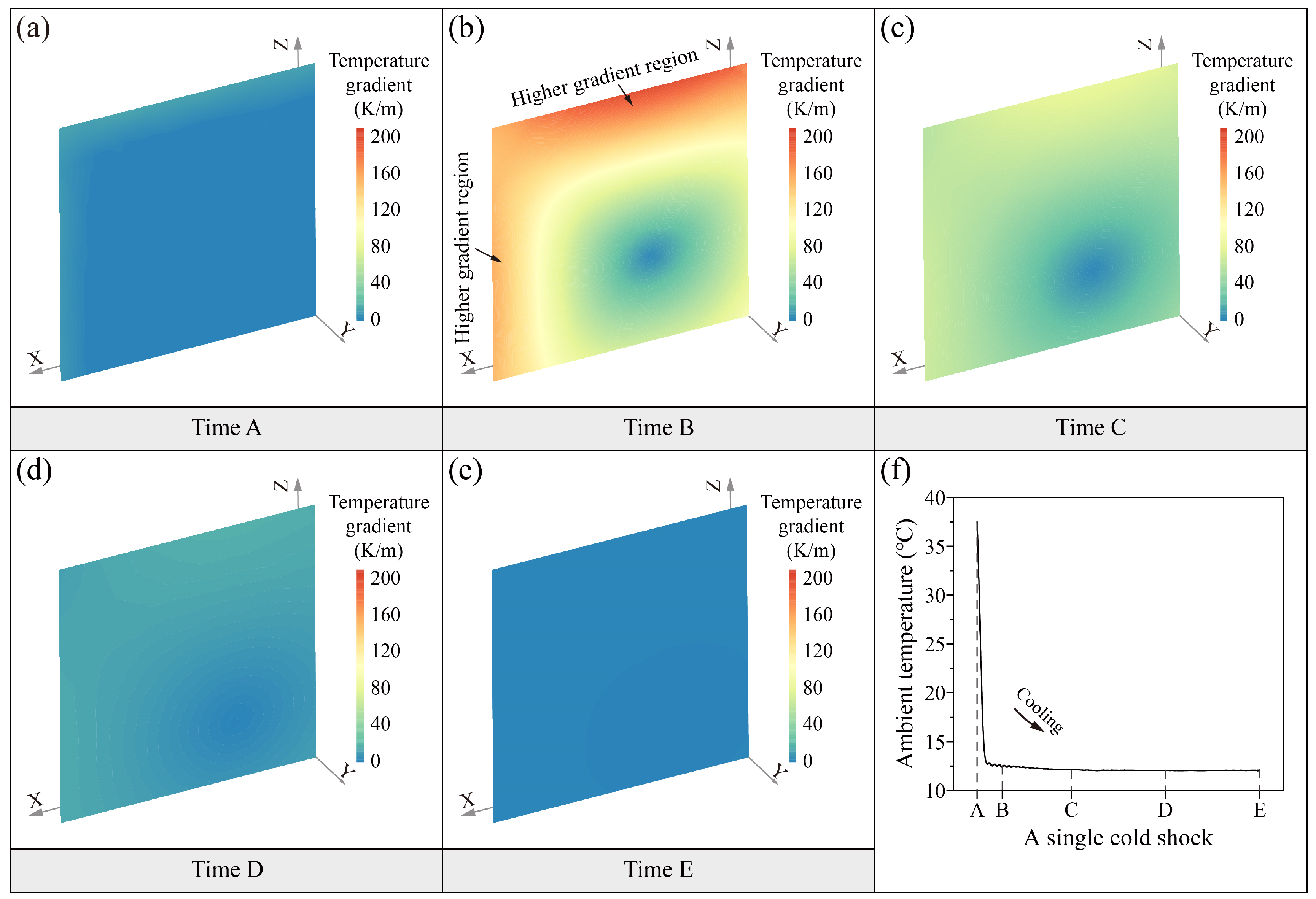Thermo-Mechanical Weathering in Malan Loess Under Thermal Shocks
Abstract
:1. Introduction
2. Methods
2.1. Sample Preparation
2.2. Indoor Thermal Shock Tests
2.3. Numerical Simulation
3. Results
3.1. Temperature Characteristics
3.2. Thermal Stress Characteristics
4. Discussion
4.1. Temperature Gradients of Thermal Shocks
4.2. Mechanisms of Thermal Shocks
5. Conclusions
- (1)
- Thermal transport dynamics: Soil thermal fluctuations exhibit phase-lagged synchronization with ambient variations governed by thermal convection-conduction coupling. The low thermal diffusivity of loess induces progressive thermal wave attenuation, creating a hysteresis between surface and interior temperature extrema.
- (2)
- Gradient-stress coupling: Thermal stress evolution is fundamentally governed by the spatiotemporal distribution of thermal gradients within the soil matrix.
- (3)
- Anisotropic stress partitioning: While the magnitudes of thermal stress remain comparable between shock types (heat and cold), their directional characteristics demonstrate discrepancy; heat shocks induce surface compression and interior tension, whereas cold shocks generate surface tension and interior compression.
- (4)
- Cold shock-induced degradation: In contrast to thermally benign heat shocks, cold shocks generate critical surface tensile stresses exceeding the interparticle bond strength and cause loess degradation.
Author Contributions
Funding
Institutional Review Board Statement
Informed Consent Statement
Data Availability Statement
Conflicts of Interest
References
- Wang, B.; Zheng, F.; Römkens, M.J.; Darboux, F. Soil erodibility for water erosion: A perspective and Chinese experiences. Geomorphology 2013, 187, 1–10. [Google Scholar] [CrossRef]
- Xiong, M.; Leng, G. Global soil water erosion responses to climate and land use changes. Catena 2024, 241, 108043. [Google Scholar] [CrossRef]
- Zhang, C.; Guo, S.; Guan, Y.; Cai, D.; Bian, X. Temporal stability of vegetation cover across the loess plateau based on GIMMS during 1982–2013. Sensors 2021, 21, 315. [Google Scholar] [CrossRef]
- García-García, A.; Cuesta-Valero, F.J.; Miralles, D.G.; Mahecha, M.D.; Quaas, J.; Reichstein, M.; Zscheischler, J.; Peng, J. Soil heat extremes can outpace air temperature extremes. Nat. Clim. Change 2023, 13, 1237–1241. [Google Scholar] [CrossRef]
- Lin, S.; Wang, L.; Zhang, W.; Wang, S.; Zhang, K.; Lei, Y.; Jiang, S.; Chen, H.; Zhao, G.; Feng, X. Cross-Scale Quantitative and Qualitative Study of Grotto Sandstone Under Salt Weathering. Rock Mech. Rock Eng. 2024, 57, 10953–10971. [Google Scholar] [CrossRef]
- Eppes, M.C.; Magi, B.; Hallet, B.; Delmelle, E.; Mackenzie-Helnwein, P.; Warren, K.; Swami, S. Deciphering the role of solar-induced thermal stresses in rock weathering. Geol. Soc. Am. Bull. 2016, 128, 1315–1338. [Google Scholar] [CrossRef]
- Molaro, J.; Byrne, S. Rates of temperature change of airless landscapes and implications for thermal stress weathering. J. Geophys. Res. 2012, 117, E10011. [Google Scholar] [CrossRef]
- Hall, K.; Thorn, C.E. Thermal fatigue and thermal shock in bedrock: An attempt to unravel the geomorphic processes and products. Geomorphology 2014, 206, 1–13. [Google Scholar] [CrossRef]
- Feng, L.; Zhang, M.S.; Jin, Z.; Zhang, S.S.; Sun, P.P.; Gu, T.F.; Liu, X.B.; Lin, H.; An, Z.S.; Peng, J.B.; et al. The genesis, development, and evolution of original vertical joints in loess. Earth Sci. Rev. 2021, 214, 103526. [Google Scholar] [CrossRef]
- Feng, L.; Lin, H.; Zhang, M.S.; Guo, L.; Zhao, J.; Liu, X.B. Development and evolution of Loess vertical joints on the Chinese Loess Plateau at different spatiotemporal scales. Eng. Geol. 2020, 265, 105372. [Google Scholar] [CrossRef]
- Huo, B.Y.; Huang, Q.B.; Kang, X.S.; Liu, X.; Liu, M.H.; Peng, J.B. Experimental study on the disintegration characteristics of undisturbed loess under rainfall-induced leaching. Catena 2023, 233, 107482. [Google Scholar] [CrossRef]
- Lu, Y.C.; Lu, T.; Lu, Y.D.; Wang, B.; Zeng, G.H.; Zhang, X. The Study on Solving Large Pore Heat Transfer Simulation in Malan Loess Based on Volume Averaging Method Combined with CT Scan Images. Sustainability 2023, 15, 12389. [Google Scholar] [CrossRef]
- Sun, W.Y.; Mu, X.M.; Song, X.Y.; Wu, D.; Cheng, A.F.; Qiu, B. Changes in extreme temperature and precipitation events in the Loess Plateau (China) during 1960–2013 under global warming. Atmos. Res. 2016, 168, 33–48. [Google Scholar] [CrossRef]
- Eppes, M.C.; Keanini, R. Mechanical weathering and rock erosion by climate-dependent subcritical cracking. Rev. Geophys. 2017, 55, 470–508. [Google Scholar] [CrossRef]
- Gunzburger, Y.; Merrien-Soukatchoff, V.; Guglielmi, Y. Influence of daily surface temperature fluctuations on rock slope stability: Case study of the Rochers de Valabres slope (France). Int. J. Rock Mech. Min. Sci. 2005, 42, 331–349. [Google Scholar] [CrossRef]
- Collins, B.D.; Stock, G.M. Rockfall triggering by cyclic thermal stressing of exfoliation fractures. Nat. Geosci. 2016, 9, 395–400. [Google Scholar] [CrossRef]
- Bakun-Mazor, D.; Hatzor, Y.H.; Glaser, S.D.; Santamarina, J.C. Thermally vs seismically induced block displacements in Masada rock slopes. Int. J. Rock Mech. Min. Sci. 2013, 61, 196–211. [Google Scholar] [CrossRef]
- Wang, Z.; Thomas, B.; Zhang, W.; Gu, D. A novel random angular bend (RAB) algorithm and DEM modeling of thermal cracking responses of sandstone. Geomech. Energy Environ. 2022, 32, 100335. [Google Scholar] [CrossRef]
- Huang, Y.H.; Yang, S.Q.; Bu, Y.S. Effect of thermal shock on the strength and fracture behavior of pre-flawed granite specimens under uniaxial compression. Theor. Appl. Fract. Mech. 2020, 106, 102474. [Google Scholar] [CrossRef]
- Lamp, J.L.; Marchant, D.R.; Mackay, S.L.; Head, J.W. Thermal stress weathering and the spalling of Antarctic rocks. J. Geophys. Res. Earth Surf. 2017, 122, 3–24. [Google Scholar] [CrossRef]
- Lu, T.J.; Fleck, N.A. The thermal shock resistance of solids. Acta Mater. 1998, 46, 4755–4768. [Google Scholar] [CrossRef]
- Gage, H.J.M.; Eyles, C.H.; Peace, A. Winter weathering of fractured sedimentary rocks in a temperate climate: Observation of freeze–thaw and thermal processes on the Niagara Escarpment, Hamilton, Ontario. Geol. Mag. 2022, 159, 2060–2081. [Google Scholar] [CrossRef]
- Eppes, M.C. Mechanical Weathering: A Conceptual Overview. Treatise Geomorphol. 2022, 3, 30–45. [Google Scholar] [CrossRef]
- Browning, J.; Meredith, P.; Gudmundsson, A. Cooling-dominated cracking in thermally stressed volcanic rocks. Geophys. Res. Lett. 2016, 43, 8417–8425. [Google Scholar] [CrossRef]
- Shen, Y.J.; Hou, X.; Yuan, J.Q.; Wang, S.F.; Zhao, C.H. Thermal cracking characteristics of high-temperature granite suffering from different cooling shocks. Int. J. Fract. 2020, 225, 153–168. [Google Scholar] [CrossRef]
- Li, X.; Fan, X.D.; Tao, M.; Yin, T.B.; Huang, S. Damage effect of thermal shock on the heated granite at different cooling rates. Buildings 2023, 13, 629. [Google Scholar] [CrossRef]
- Li, X.; Huang, S.; Yin, T.B.; Li, X.B.; Peng, K.; Fan, X.D. Experimental investigation on the energy properties and failure process of thermal shock treated sandstone subjected to coupled dynamic and static loads. Minerals 2022, 12, 25. [Google Scholar] [CrossRef]
- Eppes, M.C.; Griffing, D. Granular disintegration of marble in nature: A thermal-mechanical origin for a grus and corestone landscape. Geomorphology 2010, 117, 170–180. [Google Scholar] [CrossRef]
- Hall, K.; André, M.F. Rock thermal data at the grain scale: Applicability to granular disintegration in cold environments. Earth Surf. Proc. Landf. J. Br. Geomorphol. Res. Group 2003, 28, 823–836. [Google Scholar] [CrossRef]
- Wang, S.; Wang, L.; Zhang, W.; Lin, S.; Sun, W.; Jiang, S.; Zhao, G.; Li, X.; Wang, C.; Xiong, Z. Microstructural deterioration mechanism and failure mode of water-immersed sandstone under uniaxial compression in Dazu rock carvings. Eng. Fract. Mech. 2025, 321, 111110. [Google Scholar] [CrossRef]
- Wang, Y.Q.; Hu, W.; Sun, H.; Zhao, Y.L.; Zhang, P.P.; Li, Z.M.; Zhou, Z.X.; Tong, Y.P.; Liu, S.Z.; Zhou, J.X.; et al. Soil moisture decline in China’s monsoon loess critical zone: More a result of land-use conversion than climate change. Proc. Natl. Acad. Sci. USA 2024, 121, e2322127121. [Google Scholar] [CrossRef] [PubMed]
- GB/T 50123-2019; Standard Test for Soil Test Method. China Planning Press: Beijing, China, 2019.
- Yuan, Z.X.; Wang, L.M. Collapsibility and seismic settlement of loess. Eng. Geol. 2009, 105, 119–123. [Google Scholar] [CrossRef]
- Li, Y.R.; Mo, P.; Wang, Y.F.; Zhang, T.; Zhang, H.W. Strength anisotropy of Malan loess and the implications for the formation of loess walls and columns. Catena 2020, 194, 104809. [Google Scholar] [CrossRef]
- Li, Y.R.; He, S.D.; Deng, X.H.; Xu, Y.X. Characterization of macropore structure of Malan loess in NW China based on 3D pipe models constructed by using computed tomography technology. J. Asian Earth Sci. 2018, 154, 271–279. [Google Scholar] [CrossRef]
- Jafari, A.; Vahab, M.; Broumand, P.; Khalili, N. An eXtended finite element method implementation in COMSOL multiphysics: Thermo-hydro-mechanical modeling of fluid flow in discontinuous porous media. Comput. Geotech. 2023, 159, 105458. [Google Scholar] [CrossRef]
- Vajdi, M.; Moghanlou, F.S.; Sharifianjazi, F.; Asl, M.S.; Shokouhimehr, M. A review on the Comsol Multiphysics studies of heat transfer in advanced ceramics. J. Compos. Compd. 2020, 2, 35–43. [Google Scholar] [CrossRef]
- Li, Y.R.; Guan, F.F.; Su, H.; Aydin, A.; Beroya-Eitner, M.A.; Zachert, H. A new direct tension test method for soils and soft rocks. Geotech. Test. J. 2020, 43, 1317–1334. [Google Scholar] [CrossRef]
- Kunii, D.; Smith, J.M. Heat transfer characteristics of porous rocks. AIChE J. 1960, 6, 71–78. [Google Scholar] [CrossRef]
- Chen, Y.; Zhao, Z. Heat transfer in a 3D rough rock fracture with heterogeneous apertures. Int. J. Rock Mech. Min. Sci. 2020, 134, 104445. [Google Scholar] [CrossRef]
- Lan, H.X.; Zhao, X.X.; Macciotta, R.; Peng, J.B.; Li, L.P.; Wu, Y.M.; Zhu, Y.B.; Liu, X.; Zhang, N.; Liu, S.J.; et al. The cyclic expansion and contraction characteristics of a loess slope and implications for slope stability. Sci. Rep. 2021, 11, 2250. [Google Scholar] [CrossRef]
- Tsilingiridis, G.; Papakostas, K. Investigating the relationship between air and ground temperature variations in shallow depths in northern Greece. Energy 2014, 73, 1007–1016. [Google Scholar] [CrossRef]
- Romio, L.C.; Zimmer, T.; Bremm, T.; Buligon, L.; Herdies, D.L.; Roberti, D.R. Influence of different methods to estimate the soil thermal properties from experimental dataset. Land 2022, 11, 1960. [Google Scholar] [CrossRef]
- Huang, X.; Tang, S.B.; Tang, C.A.; Xie, L.M.; Tao, Z.Y. Numerical simulation of cracking behavior in artificially designed rock models subjected to heating from a central borehole. Int. J. Rock Mech. Min. Sci. 2017, 98, 191–202. [Google Scholar] [CrossRef]
- Zhang, P.J.; Wang, C.S.; Wu, G.S.; Wang, Y. Temperature gradient models of steel-concrete composite girder based on long-term monitoring data. J. Constr. Steel Res. 2022, 194, 107309. [Google Scholar] [CrossRef]
- Kant, M.A.; Ammann, J.; Rossi, E.; Madonna, C.; Höser, D.; von Rohr, P.R. Thermal properties of Central Aare granite for temperatures up to 500 °C: Irreversible changes due to thermal crack formation. Geophys. Res. Lett. 2017, 44, 771–776. [Google Scholar] [CrossRef]
- Wang, X.M.; Zhu, B.Q.; Wang, Z.T.; Zhang, C.X.; Geng, X.; Han, L.K.; Zheng, Y.; Cai, D.W.; Li, D.F. Physical weathering of Gobi Desert sediments under different temperature and humidity conditions. Catena 2024, 234, 107597. [Google Scholar] [CrossRef]
- Wang, R.; Li, Y.R.; Guan, F.F.; Fan, W.H.; Ma, T.Y. Mode I fracturing behavior of Malan loess and implications for the toppling failure of loess slopes. Eng. Geol. 2023, 319, 107110. [Google Scholar] [CrossRef]
- Draebing, D.; Krautblatter, M.; Hoffmann, T. Thermo-cryogenic controls of fracture kinematics in permafrost rockwalls. Geophys. Res. Lett. 2017, 44, 3535–3544. [Google Scholar] [CrossRef]











| Basic Physical Properties | ||
|---|---|---|
| Density, ρ | 1421 kg/m3 | |
| Water content, w | 1.8% | |
| Specific gravity, Gs | 2.70 | |
| Particle size distribution | Clay (<5 μm) | 20.5% |
| Silt (5–75 μm) | 73.4% | |
| Sand (>75 μm) | 6.1% | |
| Mechanical properties [33] | ||
| Elastic modulus, E | 100 MPa | |
| Poisson’s ratio, μ | 0.3 | |
| Thermal properties | ||
| Specific heat capacity, c | 1216.3 J/kg·K | |
| Thermal conductivity, λ | X: 0.79 W/m·k | |
| Y: 0.68 W/m·k | ||
| Z: 0.93 W/m·k | ||
| Thermal expansion coefficient, α | X: 1.45 × 10−5 K−1 | |
| Y: 1.51 × 10−5 K−1 | ||
| Z: 2.20 × 10−5 K−1 | ||
Disclaimer/Publisher’s Note: The statements, opinions and data contained in all publications are solely those of the individual author(s) and contributor(s) and not of MDPI and/or the editor(s). MDPI and/or the editor(s) disclaim responsibility for any injury to people or property resulting from any ideas, methods, instructions or products referred to in the content. |
© 2025 by the authors. Licensee MDPI, Basel, Switzerland. This article is an open access article distributed under the terms and conditions of the Creative Commons Attribution (CC BY) license (https://creativecommons.org/licenses/by/4.0/).
Share and Cite
Gong, Y.; Li, Y.; He, S. Thermo-Mechanical Weathering in Malan Loess Under Thermal Shocks. Sensors 2025, 25, 3115. https://doi.org/10.3390/s25103115
Gong Y, Li Y, He S. Thermo-Mechanical Weathering in Malan Loess Under Thermal Shocks. Sensors. 2025; 25(10):3115. https://doi.org/10.3390/s25103115
Chicago/Turabian StyleGong, Yangqing, Yanrong Li, and Shengdi He. 2025. "Thermo-Mechanical Weathering in Malan Loess Under Thermal Shocks" Sensors 25, no. 10: 3115. https://doi.org/10.3390/s25103115
APA StyleGong, Y., Li, Y., & He, S. (2025). Thermo-Mechanical Weathering in Malan Loess Under Thermal Shocks. Sensors, 25(10), 3115. https://doi.org/10.3390/s25103115





